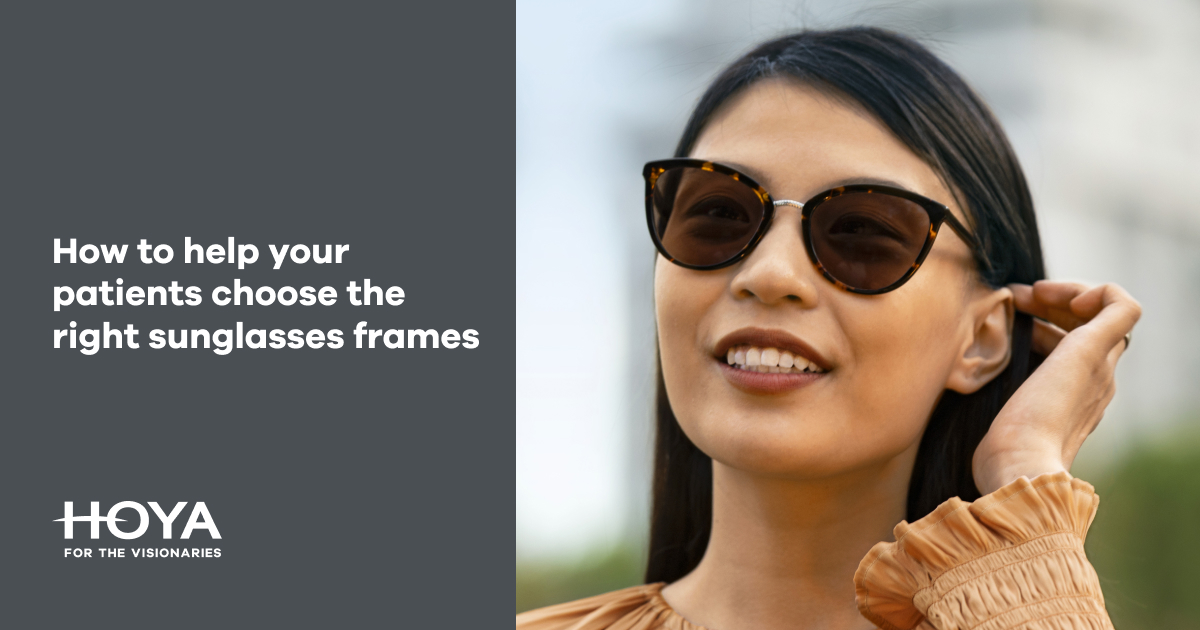As an eye care professional, you care about delivering your patient the proper UV eye protection to avoid long-term impacts to their vision. Your patients, on the other hand, often think about the comfort, fit, and style of the frame.
The goal is to combine those: help patients understand the importance of UV protection, without sacrificing style or comfort. During sun season, you can increase patient satisfaction while increasing your sunglasses sales – by helping your patients find the sunglasses frames that are right for them.
Key considerations for how to choose sunglasses frames for your patients
As you help your patients choose the best sunglasses frames for themselves, here are the features you need to pay attention to the most.
The bridge of the nose
Focus on the contact area, without pinching your patient’s nose. With more contact area, the bridge of the nose can provide more stability and comfort for patients. The last thing they want to do is adjust their sunglasses over and over again.
Another factor to consider is ensuring that the patient’s pupil is centred vertically within the lens opening.
Frame size
When it comes to selecting types of sunglasses frames, consider larger sizes and frame widths. While sun damage to the eye itself is possible, the skin around the eye is also at risk. Find frames that cover a large enough area to provide full protection.
Temple length
Sunglasses must be ready to take on punishment from a day on a boat, or an afternoon of exercise. They need to fit securely, even when perspiring. For frames with temples that bend behind the ears, ensure the bend is in the appropriate position with enough temple behind the ear to adjust for a secure fit.
Frames with straight temples need adequate tension, with a sufficient touch of the temples to the side of the head beyond the top of the ears — with minimal touch in front of the ears.
The patient may want something for its style alone, but make sure they understand the pros and cons of different options. The wrong fit may cause discomfort for them regardless of the style.
Sunglasses for face shape
When guiding patients on sunglasses shape, you can use the same guidelines you use with any pair of glasses. Emphasize some facial and other characteristics while outbalancing others.
Consider the patient’s face shape, contrast, and proportion. The frames should contrast the shape of the patient’s face, whether they have a square-shaped face or a heart-shaped face. Sunglasses cover more surface of the face to provide adequate UV protection (not to mention larger sunglasses are almost always trending).
Quality materials
When determining materials for different types of sunglasses, you have to take into consideration the fit and function of the sunglasses themselves. Sunglasses for sports and activewear must be lightweight and impact resistant. Phoenix and polycarbonate lenses are strong contenders, while plastics or metals with safety hinges offer durable support.
Thinking outside the frames for prescription sunglasses
Here’s a quick checklist for helping your patient choose prescription sunglasses, including the lenses.
Prescription sunwear is the best eye health solution to protect the eyes, eyelids, and skin around the eyes from sun-related damage. With so many advancements in lens technology just over the last decade, these are the features your patients should look for in prescription sunglasses:
- 100% UV protection
- Solar blue light protection
- Comfort
- Visual clarity
- Enhanced contrast
- Impact protection
- Glare reduction
- Extra darkness outdoors
- Style variety
- Affordability
- Indoor/outdoor setting (optional)
Some patients may be unwilling to carry two pairs of glasses and therefore think prescription sun lenses are a hassle. Approach this objection by recommending a photochromic option, providing wearers with the lens comfort they need in all different light situations possible.
This allows a range of combinations that suit different wearer needs and can be tailored for almost all HOYA lens designs. For example, lenses like our Sensity® 2 light-adaptive lenses offer you more comfort and convenience in all light conditions without sacrificing style.
How to sell more prescription sunglasses
At the end of the day, you're trying to run a business on top of being the trusted eyecare provider for your community. Here are some tips for encouraging your patients to get a pair of prescription sunglasses this season:
- Use sun season to start the right conversations
- Be specific about UV damage to each part of the eye
- Keep it conversational and educational
- Break down the benefits of prescription sunglasses
- Promote prescription sunglasses variety and affordability
- Talk about prescription sun lenses in the middle of the exam instead of at the end
- Make recommendations based on lifestyle
- Consider adding questions to patient intake forms that could help initiate conversations based on family history, time spent outdoors, and time driving
Frames complete a pair of high-quality glasses
It’s easy to focus on lens features or let patients pick something that doesn’t match their original needs. Frames need proper consideration for the final product.
It's hard enough to encourage patients to purchase a second pair of glasses. Streamline the process for them. Help your patients decide on a frame that will fit their face shape and their lifestyle while also supporting their eye health with the right prescription sun lenses.
